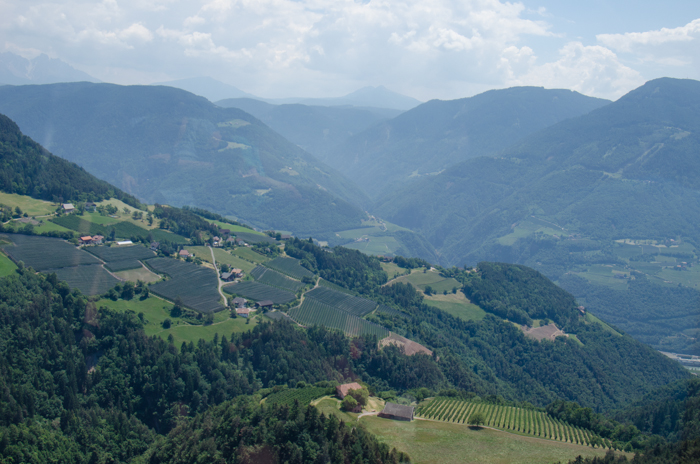 Nestled within picturesque green hills lies Bolzano, Italy – the capital of Alto Adige/Sudtirol, and the gateway to the Dolomites. It’s an easy destination to get to, with its own airport, or a couple of hours drive or train ride from Venice to the south, Innsbruck, Austria and Munich, Germany to the north. And its proximity to the heart of the magnificent Dolomite mountains make it a perfect base for ski holiday or summer bike tour.
Nestled within picturesque green hills lies Bolzano, Italy – the capital of Alto Adige/Sudtirol, and the gateway to the Dolomites. It’s an easy destination to get to, with its own airport, or a couple of hours drive or train ride from Venice to the south, Innsbruck, Austria and Munich, Germany to the north. And its proximity to the heart of the magnificent Dolomite mountains make it a perfect base for ski holiday or summer bike tour.
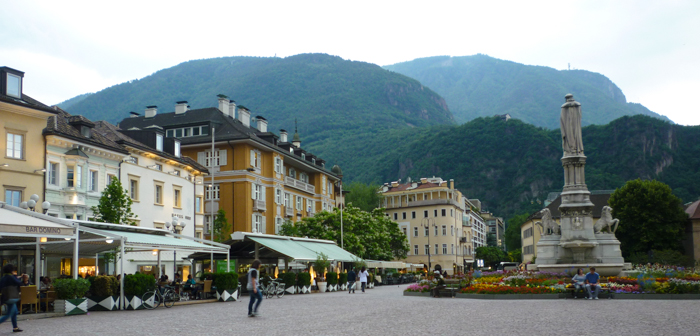
Bolzano is small and welcoming, with many attractions within a short of walk. Originally a Roman settlement, the town became an important trading post on the Transalpine Augsburg-Venice route over the Brenner Pass, within the Holy Roman Empire. Beginning in the 14th century, a large market was organized four times per year for merchants traveling through the Brenner Pass. A Mercantile Magistrate was founded in 1635 by the Austrian duchess Claudia de’ Medici. During every market season, two Italian and two Germanic officers, appointed among the local merchants, worked in this magistrate office. This established Bolzano as a cultural crossroad in the Alps.
After the fall of the Roman Empire, immigrants arrived from Bavaria to the north, and the area has been settled by German populations since then. Before World War 1, Bolzano was part of the Austro-Hungarian county of Tyrol, and became part of Italy at the end of this war. This cultural heritage is still prevalent throughout the region, from its bilingual street signs and town names, to its foods of wurst and spaetzle, to wines such as Vernatsch (Schiava) and Blauburgunder (Pinot Noir).
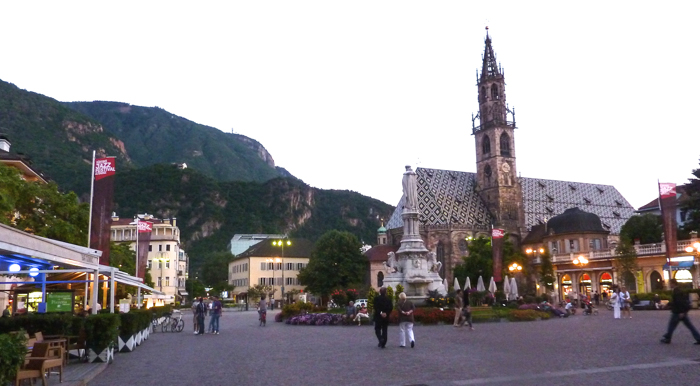
A great place to start in Bolzano is at Piazza Walthur, named for a 13th-century German minstrel. There, you can sit at any one of a number of cafes, enjoying a prosecco, people-watching and soaking up your surroundings – steep hills that tower over the city, and the majestic Duomo, with it’s campanile dating from the 16th century. Don’t overlook the small wine ‘door’, decorated with details of grapes and vines. Historically, the church once had the exclusive right to sell wine from this doorway.
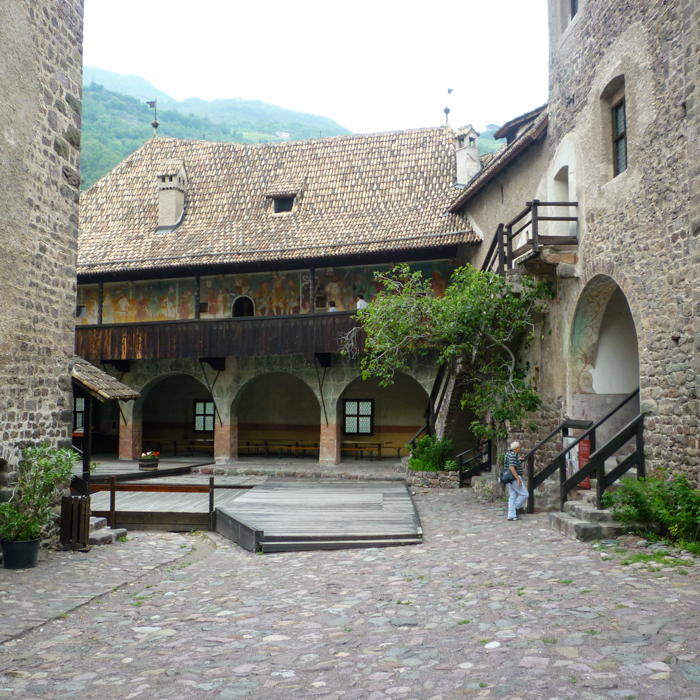
The town’s most famous attraction, Ötzi the Iceman, dates from about 3300 BC. Ötzi, and a nice collection of his household goods, clothes, and tools (more interesting than Ötzi himself) are on exhibit at the South Tyrol Museum of Archaeology. Bolzano’s modern and contemporary art museum, the Museion, opened in 2008. A short distance outside the town lies some lovely castles, including Castle Maretsch, Runkelstein Castle and Firmian/Sigmundskron Castle.
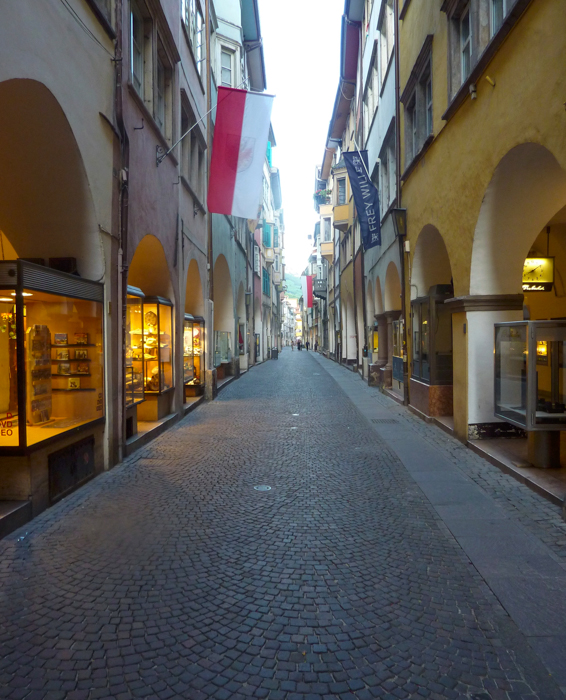 When you are ready for some shopping, you can find a wide variety of shops from local handicrafts to designer clothing, all along the porticoed streets. These covered walkways make shopping a pleasant experience rain, shine, or snow. Several of the these streets end at Piazza delle Erbe, the central market of Bolzano. As a chef and insatiable foodie, this is my favorite place to shop, where I can loose myself exploring the fresh produce, local salumi and cured meats, and specialty cheeses. All of this beautiful food makes me hungry, but fortunately there are a couple of wonderful restaurants right here on the Piazza.
When you are ready for some shopping, you can find a wide variety of shops from local handicrafts to designer clothing, all along the porticoed streets. These covered walkways make shopping a pleasant experience rain, shine, or snow. Several of the these streets end at Piazza delle Erbe, the central market of Bolzano. As a chef and insatiable foodie, this is my favorite place to shop, where I can loose myself exploring the fresh produce, local salumi and cured meats, and specialty cheeses. All of this beautiful food makes me hungry, but fortunately there are a couple of wonderful restaurants right here on the Piazza.
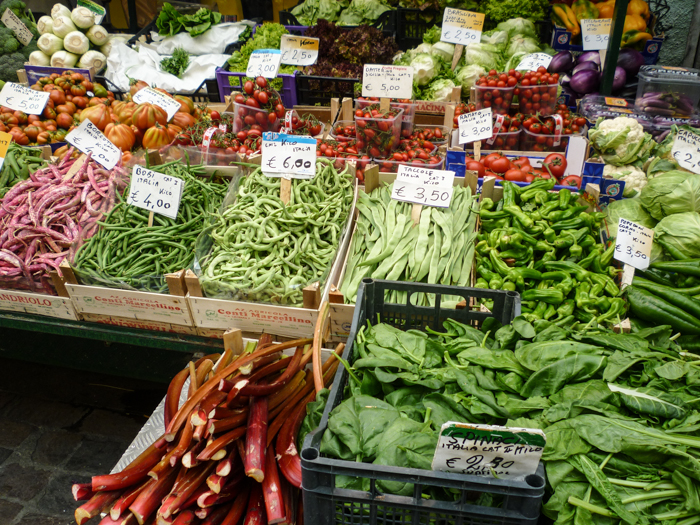
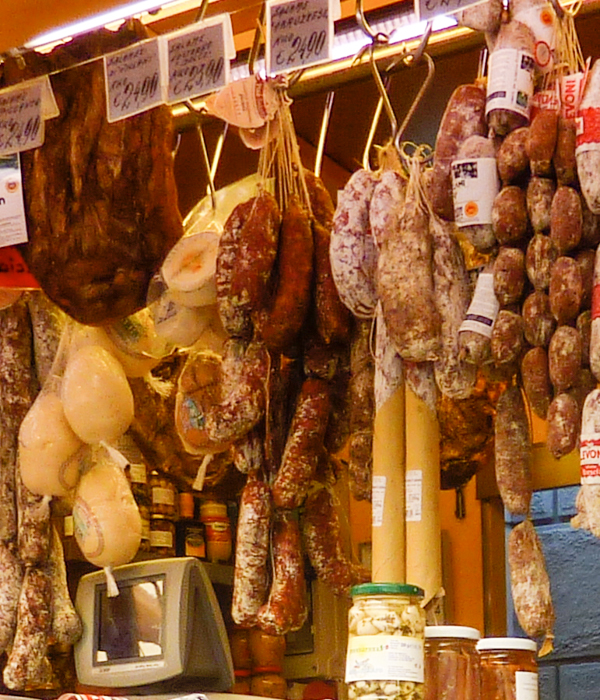 Hopfen & Co. is a what we in the US might call a brew pub. It offers an nice selection of local foods, accompanied by their homemade Bozner bier. The first floor consists of a couple of small rooms, the first one dominated by their large bar. During the warmer months, you will see most of the action at their pleasant outdoor tables. They had a dark, lager, and weiss beers, as well as a small selection of local wines, including Lagrein, Santa Maddalena and Teroldego.
Hopfen & Co. is a what we in the US might call a brew pub. It offers an nice selection of local foods, accompanied by their homemade Bozner bier. The first floor consists of a couple of small rooms, the first one dominated by their large bar. During the warmer months, you will see most of the action at their pleasant outdoor tables. They had a dark, lager, and weiss beers, as well as a small selection of local wines, including Lagrein, Santa Maddalena and Teroldego.
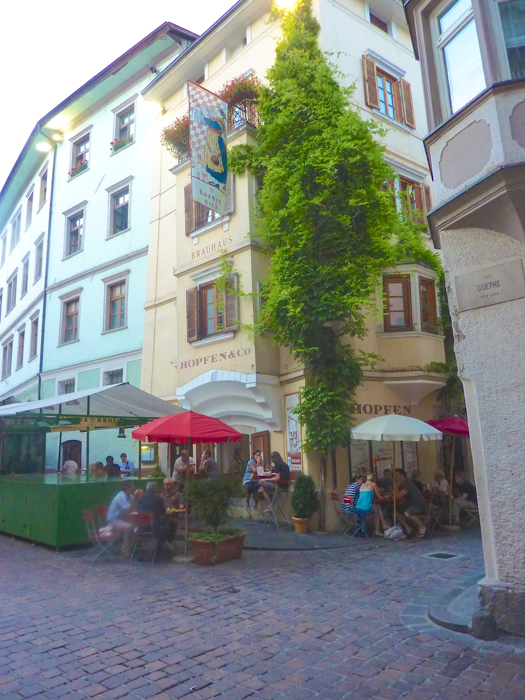 The menu included some traditional sausages, including wurstel bianchi and salsicce di noremburger, and dishes like homemade gnocchi, canderli, spaetzle, goulash, stinco di maiale (pork shank), and veal liver with rice. I very much enjoyed my spaetzle, prepared with bacon and cheese, and served in a saute pan. It was accompanied by some of the best bread I’ve had yet in Northern Italy; a basket of assorted lighter rye breads, one with strong caraway, another with more of whole grain texture.
The menu included some traditional sausages, including wurstel bianchi and salsicce di noremburger, and dishes like homemade gnocchi, canderli, spaetzle, goulash, stinco di maiale (pork shank), and veal liver with rice. I very much enjoyed my spaetzle, prepared with bacon and cheese, and served in a saute pan. It was accompanied by some of the best bread I’ve had yet in Northern Italy; a basket of assorted lighter rye breads, one with strong caraway, another with more of whole grain texture.
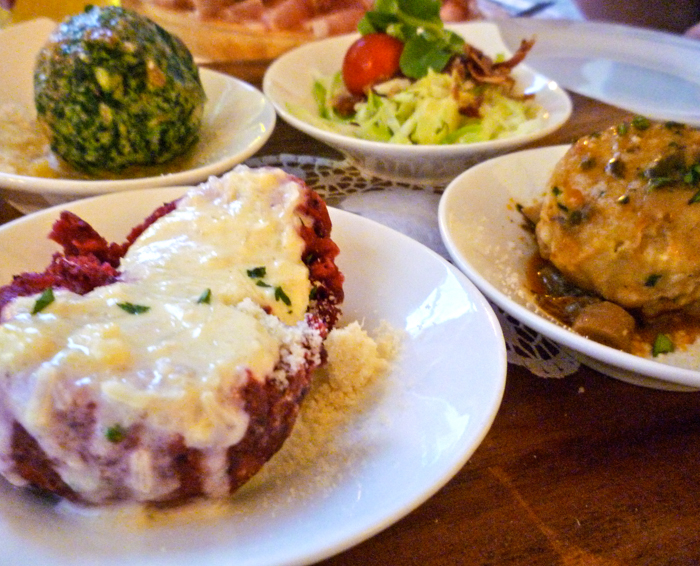 Right next door is another great dining destination, Vogele. A more upscale ristorante, serving a mix of traditional fare as well as more Mediterranean dishes. Antipasti included prosciutto with melon, mozzarella with tomato and grilled zucchini, and cavatelli with octopus to mixed grilled meats with sauerkraut and potatoes. Also on the menu, a variety of canderli with sauerkraut, ravioli stuffed with fish served with a prosecco crema, and tagliatelle with fresh local mushrooms.
Right next door is another great dining destination, Vogele. A more upscale ristorante, serving a mix of traditional fare as well as more Mediterranean dishes. Antipasti included prosciutto with melon, mozzarella with tomato and grilled zucchini, and cavatelli with octopus to mixed grilled meats with sauerkraut and potatoes. Also on the menu, a variety of canderli with sauerkraut, ravioli stuffed with fish served with a prosecco crema, and tagliatelle with fresh local mushrooms.
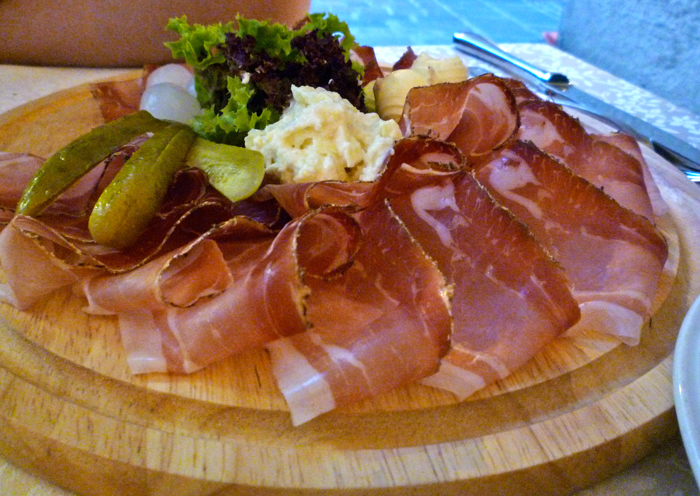 During my last visit, we began with a beautiful platter of the local cured ham, speck – a smoked prosciutto, served with horseradish, butter, and pickled onion. We enjoyed a sampler of canederli, a rounded dumpling made from stale bread crumbs and flavored many different ways. Our sampler included a beautiful beet canederli, served with a tangy horseradish sauce, a mushroom dumpling with a ragu, and a very typical spinach canederli served in a brown butter sauce. Other favorites included goulash with canderli with speck, a veal cutlet with oven fries, and a grilled orato, a white fish native to the Adriatic.
During my last visit, we began with a beautiful platter of the local cured ham, speck – a smoked prosciutto, served with horseradish, butter, and pickled onion. We enjoyed a sampler of canederli, a rounded dumpling made from stale bread crumbs and flavored many different ways. Our sampler included a beautiful beet canederli, served with a tangy horseradish sauce, a mushroom dumpling with a ragu, and a very typical spinach canederli served in a brown butter sauce. Other favorites included goulash with canderli with speck, a veal cutlet with oven fries, and a grilled orato, a white fish native to the Adriatic.
While in Bolzano, take advantage of its long history as a wine town, and visit a few local spots to try the region’s specialties. One spot in Bolzano proper is Cantina Convento Muri-Gries, This facility that houses this winery and convent dates back as far as the 11th century, when the Earl of Bolzano built a stronghold in an old ‘chellar’ (or cellar) to protect himself from the Bishops of Trento. In the 1400s, the then ruler of Tyrol, Earl Leopold, gave the estate to a group of monks, who had lost their monastery due to a flood. The facility has been a monastery ever since, being taken over by Benedectine monks from Muri in the Swiss Alps in 1845.
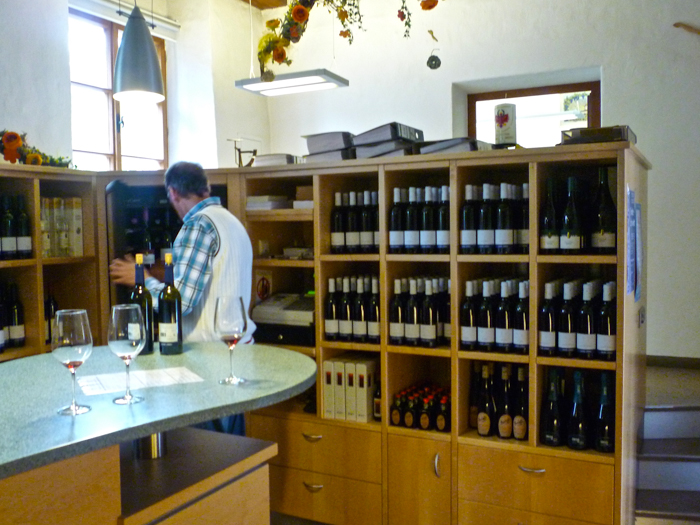 The Benedictines are a pretty serious bunch when it comes to their wines, and as the monastery entered the 20th century, there was a re-dedication to the production of quality wines. They started exporting their wines to the German speaking countries to the north, focusing on local varietals and styles like St. Magdalener, Malvasia, Lagrein, Kretzer and Gewurztraminer. Stop by their little tasting room to sample a few, and purchase some bottles for back home, as they are difficult to come by here in the US.
The Benedictines are a pretty serious bunch when it comes to their wines, and as the monastery entered the 20th century, there was a re-dedication to the production of quality wines. They started exporting their wines to the German speaking countries to the north, focusing on local varietals and styles like St. Magdalener, Malvasia, Lagrein, Kretzer and Gewurztraminer. Stop by their little tasting room to sample a few, and purchase some bottles for back home, as they are difficult to come by here in the US.
